


The term, Eighteen Weapons or martial skills (in Chinese:  ), came into use in Song and Yuan Dynasty. In one Zaju (a dramatic art form in Yuan Dynasty), Wang Huan Displaying Gallantry at Pavilion of Hundred Flowers, there is a mentioning, which says, "the treatise of the Eighteen Weapons writes about the bow, crossbow, spear, shield, dagger-axe, throwing spear, sword, halberd, whip, chain, trident-halberd and hammer." In another Zaju, Jingde not Surrendering to Old Age, the Eighteen Weapons are referred to in the line, "he has learnt the eighteen martial skills and well read Six Principles of war." Here, the martial skills refer to those of wielding weapons. Later the term entered the terminology of traditional Chinese martial arts referring to various forms of martial arts and skills. In fact, the content of the Eighteen Weapons or martial skills varies in different times.
), came into use in Song and Yuan Dynasty. In one Zaju (a dramatic art form in Yuan Dynasty), Wang Huan Displaying Gallantry at Pavilion of Hundred Flowers, there is a mentioning, which says, "the treatise of the Eighteen Weapons writes about the bow, crossbow, spear, shield, dagger-axe, throwing spear, sword, halberd, whip, chain, trident-halberd and hammer." In another Zaju, Jingde not Surrendering to Old Age, the Eighteen Weapons are referred to in the line, "he has learnt the eighteen martial skills and well read Six Principles of war." Here, the martial skills refer to those of wielding weapons. Later the term entered the terminology of traditional Chinese martial arts referring to various forms of martial arts and skills. In fact, the content of the Eighteen Weapons or martial skills varies in different times.
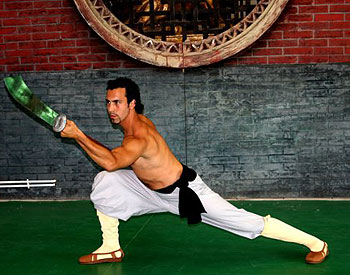
In the late Ming Dynasty during Wanli Emperor's reign (1572-1620), Xie Zhaozhi in Volume Five of his book Wu Za Zu (Five Varied Groups) writes: "the Eighteen Weapons are bow, crossbow, spear, saber, sword, throwing spear, shield, axe, deer-horn knives, halberd, whip, mace, talon, staff, fork, rake, rope and lariat and bai da." He further explains, "bai da is today's hand to hand combat or close range combat. In the eighteen martial skills, bai da is the ultimate martial skill as it does not employ any weapons." Therefore, according to Xie, the Eighteen Weapons or martial skills refer to various weapons including barehand combat.
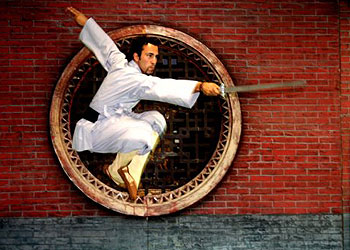
Tang Shunzhi (1507-1560), a famous Ming Dynasty General who fought against Japanese pirates, writes in Wu Bian (Treatise on Military Affairs), "the weapons for warfare have thirty six kinds with the bow as the first weapon. The weapons for martial arts have eighteen kinds with the bow as the first weapon, too." As the gun-powered weapons had low efficacy at the end of the Ming Dynasty, bows and crossbows were used as the first line long-range sharp weapons in battles. Therefore, the bow was regarded the first weapon among the thirty-six weapons for warfare and thirty-six weapons for martial arts.
Since the Qing Dynasty, there have been several versions as to what the Eighteen Weapons are. The first version holds that the Eighteen Weapons refer to the saber, spear, sword, halberd, trident-halberd, staff, fork, harrow, whip, mace, hammer, axe, hook, sickle, rake, crutch, bow and arrows and rattan shield.The second version has the same first fifteen weapons but with the last three as  , and bow and arrows. The third version categorizes the Eighteen Weapons into nine long weapons and nine short weapons. The nine long weapons are the spear, halberd, staff, deer-horn knives, fork, trident-halberd, hook, lance and rings; while the nine short weapons are the saber, sword, crutch, axe, whip, mace, hammer, cudgel and pestle cudgel. It can be noticed that the long-range projectile weapons such as bow and arrows and defense weapons such as rattan shield are no longer included in the Eighteen Weapons. This indicates that bows and arrows are not practiced by modern martial artists, who mainly teach martial arts forms. The last version held by the contemporary martial arts circle refers the Eighteen Weapons to the saber, spear, sword, Chinese halberd, battle-axe, deer-horn knives, hook sword, fork, whip, mace, hammer, talon, trident-halberd, staff, lance, cudgel, crutch and meteor hammer.
, and bow and arrows. The third version categorizes the Eighteen Weapons into nine long weapons and nine short weapons. The nine long weapons are the spear, halberd, staff, deer-horn knives, fork, trident-halberd, hook, lance and rings; while the nine short weapons are the saber, sword, crutch, axe, whip, mace, hammer, cudgel and pestle cudgel. It can be noticed that the long-range projectile weapons such as bow and arrows and defense weapons such as rattan shield are no longer included in the Eighteen Weapons. This indicates that bows and arrows are not practiced by modern martial artists, who mainly teach martial arts forms. The last version held by the contemporary martial arts circle refers the Eighteen Weapons to the saber, spear, sword, Chinese halberd, battle-axe, deer-horn knives, hook sword, fork, whip, mace, hammer, talon, trident-halberd, staff, lance, cudgel, crutch and meteor hammer.
From the above different versions, it can be concluded that at least twenty-five kinds of weapons have come under the Eighteen Weapons, not to mention various exotic and concealed weapons. In this case, in terms of exact number of categories of weapons, eighteen may be disputed. However, the term of Eighteen Weapons can be regarded as an indication of categories of Chinese martial arts weaponary and skills.
Under each category, weapons come in with different sizes, shapes and functions. For example, there are various kinds of sabers, such as nine-ring saber, goose quill saber, spring and autumn saber, three-pointed and two-bladed saber, chopping-horse saber, chopping-mountain saber and long-handled saber, etc. The diversity of weapons may be attribute to the origins and purposes of weapons. Some weapons were used in battlefield while others were developed from farming tools.
In addition, wielding weapons of different sizes and shapes require different skills and techniques to comply with their unique features. For instance, sabers are used for slashing, chopping and hacking; sword for thrusting, cutting and pricking; spear and throwing spears for long-range thrusting; and shields for blocking and warding off. To summarize, techniques of wielding weapons include chopping and cutting, slashing and hacking, thrusting and pricking, fending off and breaking off, blocking and warding off, pressing and chopping, lashing and striking, hooking and pulling, long-range shooting, as well as throwing and hurling. Therefore, in terms of their nature, the Eighteen Weapons can be categorized as follows.


The saber has many kinds with different shapes and sizes. There are blue dragon crescent blade saber (qing long yan yue dao) often referred to as the big saber, phoenix bill saber (feng zui dao), eel head saber (shan tou dao) with a broad blade, willow leaf saber (liu ye dao) with a narrow blade, goose quill saber (yan ling chi gang dao) with steel goose-quill-shaped blade, etc. Buddhist Monk's Knife (jie dao), either single or twin, is the saber used by monks for self-defense as well as for guardianship of the Buddhist Dharma. Moreover, different schools of martial arts have sabers of different shapes.
Saber has the name "the marshal of all weapons". It is likened to "fierce tiger". Saber play requires hardness and power as well as agility and flexibility. The four essentials for saber play are: vigorous and forceful; fast as a shooting star; resolute and agile; and supple as willow in the breeze.


The spear is one of the four major weapons, along with the saber, the staff and the sword. Many types of spear exist, such as sharp-pointed spear (jian qiang), flowery spear (hua qiang), double-headed spear (shuang tou qiang) and spear with a hook (gou lian qiang), etc. The flowery spear is most used in practice.
The spear has the name "the king of all weapons". The most important type of spear is the big spear (da qiang). In the past, the shaft of the spear was made of iron or bamboo. Nowadays, for practice purpose, wax wood is used. Wax wood is straight and smooth. Those with a pointed end (toward the top of the wax wood stalk) and a thicker base are ideal for spear shaft. The spearhead is made of steel and varies in shape such as willow leaf and duckbill. The spear tassel is also called blood shield to stop the flow of blood from the blade getting to the wooden shaft. It can be made of palm fiber, human hair or rhinoceros tail.
Traditionally, the flowery spear is said to be seven chi (one chi is equivalent to 33cm) long and the big spear is one zhang (one zhang is equivalent to 3.33m) and eight chi long. In fact, the length of the spear varies with the height of the wielder. Spear play is agile, swift and unpredictable. Hence, another name for the spear, "the thief of all weapons."


The sword has varieties such as single sword, twin swords and short sword. The sword is known as "the gentleman of all weapons." In ancient China, scholars wore swords and used them for physical training and defense. Swords were categorized into civil and martial swords with the difference of the former with a tassel.
Sword play represents gracefulness. It is likened to flying dragon and dancing phoenix. It combines elegance with ease; hardness with softness; motion with stillness, and music with rhythm. Techniques such as dodging, lifting, jumping and leaping are combined with various and unpredictable body movements and footwork.


The Ji, or the Chinese halberd has various types. There are long-shaft single halberd and short-shaft double halberd. Long-shaft halberds include rectangular halberd (fang ji), blue dragon halberd (qing long ji) and snake dragon halberd (she long ji). The rectangular halberd has two crescent blades while the latter two have one crescent blade. The snake dragon halberd has a bow-shaped head.
Ji has the name "the chief of all weapons". Ji play does not have rotating technique compared to spear play as in the case of sword play without the wrapping-around-the-head technique compared to saber play. Ji is often compared to dragon as in the saying, "the head of the dragon can hook, the mouth can trap, the body can hug. the claw can snatch and the tail can slap."
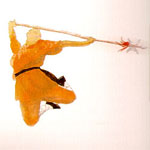

The battle-axe is one of the earliest weapons used in chariot battles in the ancient time. With a spike mounted on the top, it can be used for stabbing like a spear. The stabbing technique of battle-axe is different from that of the spear. When stabbing with a spear, the spear slides forward with fixed rear grip touching the fore grip; while with the battle-axe, both grips are fixed and the force comes from two grips. This is the so-called "dead grip", the same with the jabbing technique of the staff. Battle-axe play requires considerable arm strength.
The short-handled twin battle-axes have crescent blades. They are also called Ban Fu or broad axe due to its big head and thin poll. The length of the handle do not extend over the elbow.


The Deer Horn Knives are also called Meridian Mandarin Duck Knives (zi wu yuan yang yue). consisting of two steel crescent crossings. They are used in combination with hand combat techniques, trapping an opponent's weapon in aid of tying up or breaking the opponent's weapon, disarming the opponent. One advantage of the Deer Horn Knives in comparison to a longer weapon is that the deer horn knives are direct appendages of the hand. They can be moved with great speed and precision, and along with their ease of concealment, can easily be used to catch their opponent off guard.


It is a multi-bladed weapon and its varieties include single hook, twin hooks, and long-handled hook. Hooks are often named after their shapes, such as, eagle bill hook sword(ying zui gou) with its hook resembling the head of the shoulder pole (a Chinese carrying tool). Another type is called antler-shaped hook sword (lu jiao gou) with spikes on the hook. The long-handled hook sword has a small hook on the end of the shaft.
Hook play does not allow wrapping-around-thc-hcad technique or rotating technique. Hook play is likened to waves. The beauty of hook play lies in its rhythm and varieties of techniques. Single hook play differs from single-handed saber, single sword or single whip. It is considered to be a difficult weapon to master. It requires accuracy in demonstrating the function of the variety of blades projecting from different directions. Therefore, few people use it for practice.
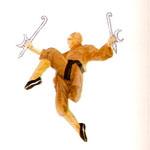

The fork is one of the long-handled weapons. It was used in ancient battles on the water. The best known is the ox head fork (niu tou cha), or the tiger fork (hu cha), with long and straight central prong and the two on the sides resembling the ox horns. The varieties of forks are numerous and they have been mainly developed into three kinds, namely, two-pronged, three-pronged and five-pronged fork. The two-pronged fork is called dragon palpus fork (long xu cha). The three-pronged fork is called triangular fork (san jiao cha). The five-pronged fork is called flying fish fork (fei yu cha).
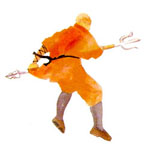

The whip is categorized as soft weapon. There are single whip, double whips, soft whip and hard whip. The single whip has two kinds. One is bamboo joint steel whip (zhu jie gang bian), composed of sections resembling bamboo joints. The other is water mill steel whip (shui mo gang bian), which has thirteen irregular-shaped cubic sections. Both of its handle and end can be used as grip and for striking. Double whip is also called male and female whip (ci xiong bian). The one for the left hand is lighter than the one for the right hand.
The soft whips can have seven, nine or thirteen sections, which are joined end-to-end by rings to form a flexible chain. It is an easily concealed weapon. It can be wrapped around the waist or folded and put into the pocket. Whip is considered as a difficult weapon to learn.
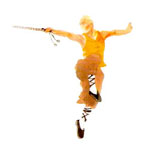

The Jian is a one-ended weapon. It looks like the hard whip, but with no joints on the body and no tip at the head. The cross section of the Jian is a diamond formation with a grove on it. Therefore it is also called the concave mace (ao mian jian).
Another weapon with similar shape to Jian is the iron ruler. It does not have concave surface on its four sides. It is thicker on the top and thinner at the end. Because it could be easily concealed, it was mostly used by constables in the old time.
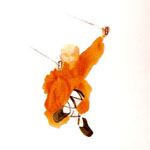

Various kinds of hammers exist. There are long-handled single hammer, short-handled twin hammers and chain hammer. Hammers are also named after the shapes of their heads, such as standing melon, lying melon, square and octagonal-shaped hammers.
The long-handled hammer is also called gold melon (jin gua). It has two types. The standing melon hammer (li gua chui) has a melon-shaped head vertically mounted on the top of the handle. The lying melon hammer (wo gua chui) has a melon-shaped head horizontally mounted on the top of the handle.
The short-handled twin hammers can also been divided into two types, the eight-flanged hammer (ba leng chui) and melon-shaped hammer (gua xing chui). The length of their handles are not extended over the elbow when in hand. The short-handled twin hammers are usually heavy and require greater strength in practice. Hammers are used for its mass and raw impact energy. Hence the saying, "a general using hammer can not be overcome with physical strength."
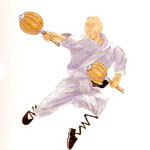

The talon is divided into long, short, single or twin types. One long talon is called golden dragon talon (Jin longzhua) with a handle more than two meters long and a hand-shaped claw at the end. The middle finger of the claw is straight and the four other fingers are crooked. Another long talon is called iron-brush talon (biyan zhua). The iron-brush talon is shaped so that the middle finger and index finger are straightforward like sword fingers, while the thumb, ring finger and little finger stay on the iron brush. One type of short-handled twin talon called tiger claw twin talons (hu zhua shuang zhua) have one-meter-long handle and a head in the shape of a hand with bent fingers mounted on the top of the handle.
There are also a few soft talons. One is the eagle claw talon (yingzhua fei zhua), made of iron in the shape of an eagle claw, tied to a long cord. Another soft talon is called double flying talons (shuangfei zhua), with one talon on each end of the cord. On the quill sealing flying talon (bi yan fei zhua), a crab-claw-shaped-talon can be found.


Different shapes of the trident-halberd, or the Tang can be found. There are phoenix-wing Tang (feng chi tang), swallow-wing Tang (yan chi tang), ox-head Tang (niu tou tang), gold-gilded Tang (liu xing tang), saw-tooth Tang (ju chi tang) and the Tang with a dart (liu xing tang). The main technique of the Tang play is twisting (nian) and vertical rotating is not allowed. Twisting technique involves big or small circles. For sayings like "Tang jabs with twisting force" or "make sure that Tang never leaves the shoulder" indicate Tang techniques.
In wielding the Tang, the front and rear grips are interchangeable. Sometimes, the left grip is in the front and sometimes, the right grip is in the front.
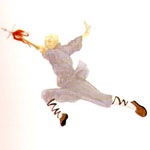

There are many kinds of staff, including big staff, eyebrow level staff (qi mei gun), short staff, lashing staff, two-section staff and staff with a dart. The big staff is the longest, eight to eight and half chi in length. The play of big staff consists of grand postures, demonstrating vigor and power. It does not allow rotating patterns.
The three-section staff is also called the first patriarch staff (tai zu gun), or curled dragon staff (pan long gun). It is constructed from three wooden staves connected by chains of rings. The whole length can reach seven to eight chi. The three-section staff can be wielded by grabbing both ends or rotated by grabbing the middle section. One section can be used for lashing while both hands grab the other two sections or two sections can be used for lashing while one hand grab the last section. Staff play with fierce movements is intimidating and forceful.
The staff is one of the four major weapons along with the saber, the sword and the spear. When the staff is called "the father of all weapons", it refers to the big staff or the eyebrow level staff.
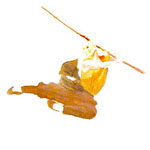

The lance is a heavy and long-ranged weapon. There are wolf fang lance (lang ya shuo), head-shaped lance (zao yang shuo), finger-shaped lance (shou shuo), palm-shaped lance (zhang shuo), weight lance (quan shuo) and steelyard arm lance (heng shuo), etc. The wolf fang lance has a handle as long as two meters and a melon-shaped hammer with six to eight rows of iron nails mounted at the end of the handle. Under the handle there is a three-flanged iron auger. The head-shaped lance is similar to the wolf fang lance with the difference in the shape of the hammer. The latter has a head-shaped hammer made of iron or wood.
Exercising with lance requires considerable strength. Hence the saying, "only those who are strong can wield the trident-halberd, the hammer and the lance."
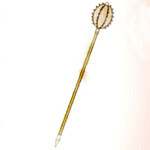

There are the wolf fang cudgel (lang ya bang). monk cudgel (xing zhe bang), five flower cudgel (wu hua bang). sentry cudgel (shao bang), pestle cudgel (chu bang) and shaft cudgel (gan bang), etc. The wolf fang cudgel resembles the wolf fang lance. The difference is that the wolf fang cudgel has a shorter handle.
The monk's cudgel is as tall as the wielder's height and rather thick. The two ends of the cudgel are wrapped with iron or bronze hoop. Cudgel technique is similar to that of the staff. The General Book of Wushu (Wu Bei Zhi) says, "Cudgel is the same as staff. It can be distinguished in the way that today's staff is the shaft cudgel and white cudgel in the old times." The sentry cudgel made of rattan is as long as four chi. In garrisons in ancient times, the sentry cudgel was used by guards and night watchmen. The shaft cudgel resembles the eyebrow level staff but shorter. The old saying has it, "cudgel is as long as it levels the chest and the staff is as long as it levels the eyebrow." There are as many sayings about the cudgels as there are many types of cudgels.
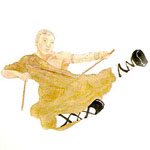

The crutch varies in sizes and in shape. The big crutch (da guai) is a single crutch while the small ones are twin crutches.
The big crutch is also called ox heart crutch (niu xin guai), four or five chi long. Because of the short cross handle on one side, some call the big crutch the ox horn crutch (niu jiao guai). The twin crutches have types called T-shaped crutches (ding zi guai), Li Gong crutches and Su Le crutches. The T-shaped crutches are about two chi and six cun long. It has a small T-shaped stake on the handle. Hence the name.
Li Gong crutches resembles the T-shaped crutches but shorter. It has a shape of the Chinese character  . The crutch play has various and unique postures and techniques. The wielder may leap into the air on the support of the crutches or leap forward as if jumping onto the boat leaving the riverbank.
. The crutch play has various and unique postures and techniques. The wielder may leap into the air on the support of the crutches or leap forward as if jumping onto the boat leaving the riverbank.
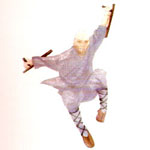

The meteor hammer is one type of soft weapon with single or twin meteors. The single meteor hammer (dan liu xing) consists of a one-and-half-zhang long rope and one bronze hammer in the shape of a melon as big as a duck's egg at the end. The meteor hammer play is likened to dragon and phoenix flying through the clouds. A skillful wielder can have the rope wrap around different parts of the body such as neck, chest, back, shoulder, elbow, wrist, legs, feet or waist before unwrapping it to release the hammer with a powerful jerk of the body. In this way, the hammer shoots forth quickly like a meteor, making a deadly impact on the target.
The twin meteor hammer (shuang liu xing) has a five-c/77-long rope and a small hammer on each end. It is considered to be a difficult weapon to master. The play applying various skills unique to meteor hammer is likened to a tempest, fast, unpredictable and dazzling.
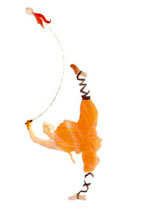
2025 Chan Wu Canada. All Rights Reserved.
Site by · Les Zurlus